In this post, we’re taking a look at the popular Hensley hitch and ProPride 3P hitch to see if either, or both, serves to eliminate trailer sway effectively.
When you’re towing a trailer, whether it’s a travel trailer or any other type of trailer, preventing sway is a paramount concern. The last thing anyone who tows wants to experience is the dreaded sway or fishtail that a gust of wind might cause, that in turn causes the driver of the tow vehicle to lose control of their rig.
In our post on methods for trailer sway control, we talked about the importance of how you load your trailer, how too much weight at the rear of the trailer is very likely to cause sway, and we discussed the importance of proper tire pressure. We also noted how improper weight distribution influences not only sway but also brake control (imagine how effective your trailer brakes are when your trailer is swaying or even fishtailing).
In later posts, we covered how trailer sway bars work to help reduce sway (not eliminate it… more on that in a bit) and the general nature of weight distribution hitches, and how they work to redistribute the tongue weight of the trailer more effectively to the towing vehicle.
But, today, we’re diving into two specific hitches – the Hensley and the ProPride 3P. We’ll talk about where the design came from, how well they work to prevent or completely eliminate sway, and whether they provide adequate weight distribution.
- 1) How Do Typical Trailer Sway Bars Work?
- 2) How Do The Hensley & ProPride Hitches Work?
- 3) What Are Hensley Hitches?
- 4) What Is a ProPride Hitch?
- 5) What’s the Difference Between the Hensley and ProPride Hitches?
- 6) So, Do Hensley & ProPride Hitches Really Eliminate Trailer Sway?
- 7) Have You Used a Hensley or ProPride Hitch?
- 8) Free RVing Tips, Tricks, Reviews, Giveaways & More
How Do Typical Trailer Sway Bars Work?
Again, as we mentioned in a previous trailer sway bar article, the most common method used to try to prevent your trailer from swaying is to introduce friction that resists the movement of the trailer around its pivot point (the hitch ball).
Without any sway control installed, the trailer is free to pivot back and forth around the ball… and that motion (whether it’s caused by wind or the gust from a passing truck) is easily transferred to the hitch ball.
Since the hitch ball is typically located several feet behind the rear axle of the towing vehicle, it has even greater leverage… multiplying the side-to-side forces and quickly causing extreme difficulty counteracting the trailer’s sway.
To reduce that force, sway control devices can introduce friction to trailer movement in several different ways. The most common is the installation of a bar or bars that connect from the side of the trailer’s tongue to an additional attachment point alongside the towing vehicle’s hitch ball.
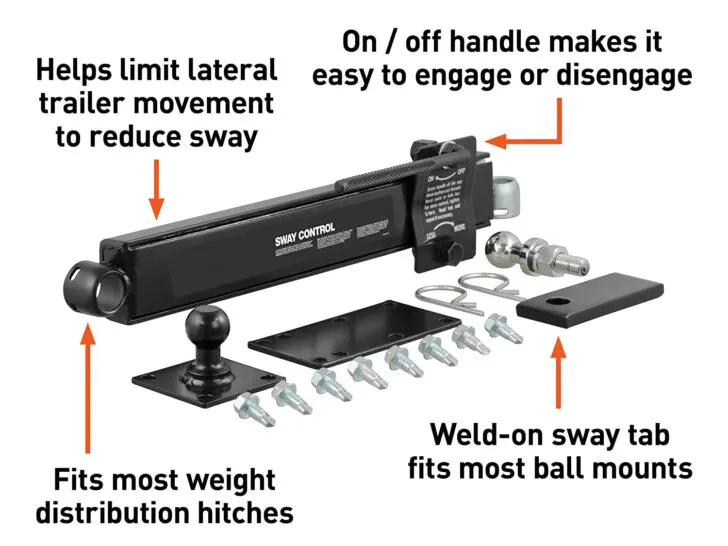
This picture shows the components used in a typical friction-based trailer sway control bar.
The problem with this type of system is that as soon as a side force is introduced to your trailer (again by wind, a passing truck, road conditions, etc.) to the extent that it’s stronger than the friction in your sway control components, you’ll be white-knuckling that steering wheel because swaying will commence immediately.
Another issue is that, because these systems are designed to reduce the amount of pivoting motion around the hitch ball, they can also reduce your maneuverability when you WANT the trailer to pivot… such as when navigating in tight spaces. And, even worse, they can actually inhibit your ability to regain control of your trailer if and when sway does begin — completely the OPPOSITE of what you hoped to achieve with installing and using one of these systems.
Finally, many sway control systems have to be disabled or removed prior to backing up your trailer. Otherwise, you risk damaging them.
How Do The Hensley & ProPride Hitches Work?
Instead of relying on friction to try to reduce trailer sway, these hitches make use of a totally different system designed to eliminate it completely.
First, an integrated yoke locks the hitch ball out as the point around which your trailer will turn.
Then, a specially-designed, trapezoidal-shaped arrangement of links (called “converging linkage”) that’s mounted alongside the now-immobilized hitch ball projects a new “virtual” (or “apparent”) pivot point forward near the rear axle of the towing vehicle. This “pivot point projection” (as ProPride calls it) creates a more stable towing situation, more akin to what you’d experience with a fifth wheel (where the kingpin sits directly above the rear axle), when influenced by outside forces like wind, passing vehicles, or road conditions.
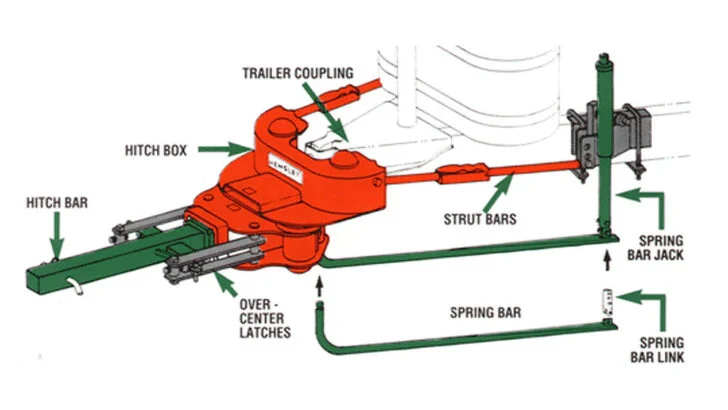
A diagram showing the components in a converging linkage design hitch. The red area highlights the yolk and linkages that lock out the hitch ball movement and project the pivot point forward. (Photo courtesy of Hensley Manufacturing)
Movement of the trailer is effectively locked out unless it’s initiated by the tow vehicle (meaning that it doesn’t hamper maneuvering the trailer for parking). Any side forces (from wind or passing vehicles) cannot cause the trailer to pivot about the hitch ball. Instead, the trailer and towing vehicle almost behave as if they were one continuous long vehicle.
That means NO SWAY! Don’t believe it? Check out this video showing an example of a model trailer using a “converging linkage” designed connection between it and the towing vehicle:
In addition, both hitch designs incorporate weight distribution, helping to ensure that the trailer’s tongue weight is more evenly applied to both the front and rear axles of the towing vehicle.
What Are Hensley Hitches?
The Hensley hitches (the “Cub” and the “Arrow”) are created using the original design of the sway-eliminating hitch described above. Created by Jim Hensley, these two Hensley hitch designs were licensed to Hensley Manufacturing for production.
Let’s take a look at each of Jim’s original hitch designs, the Arrow and the Cub.
Arrow
The Hensley Arrow® uses a convergence system that eliminates sway completely. In fact, this system is designed to make it impossible for the trailer to sway.
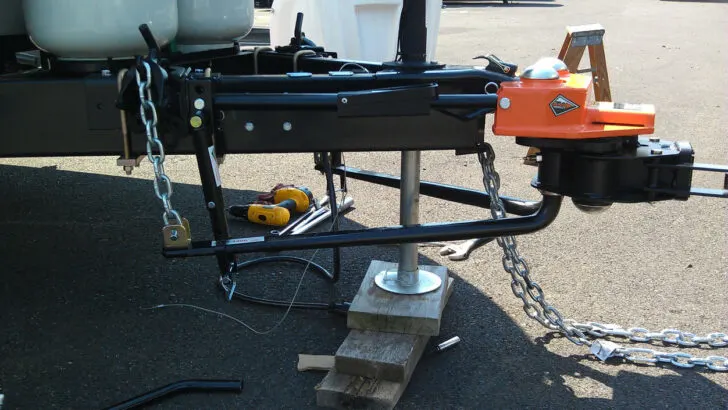
Here you see the Hensley Arrow in use. The Arrow is designed for larger trailers up to 14,000 lbs with a 1,400-lb. tongue weight. (Photo source: Hensley Manufacturing)
Because the Arrow hitch doesn’t function use friction, it has consistent, highly-predictable results regardless of road surface, passing vehicles, wind, or other weather conditions.
Hensley Manufacturing notes that in the 28 years that this hitch has been in use, they’ve never heard of a single reported incident/accident caused by sway. They even provide a 60-day money-back guarantee that, with the Hensley Arrow installed, there will be absolutely no sway experienced.
The Arrow also comes with a Lifetime Warranty for all parts and labor, so that’s a pretty hefty vote of confidence in the capabilities of their product.
The Hensley Arrow hitch is the larger of the two models, designed to handle large trailers up to 14,000 lbs GVWR and up to 1,400-lbs of tongue weight,
As a weight distribution hitch, the Arrow transfers weight from the rear axle of the tow vehicle to the front, resulting in improved ride quality, steering, and stability. But, there’s no need to lift weight distribution bars into position with this hitch.
The weight distribution feature is 100% adjustable, regardless of vehicle or trailer load.
Cub
The Hensley Cub® has all the features of the Arrow, just in a smaller package.

The Hensley Cub shares all the features of the Arrow, in a smaller, lighter package with a lower center of gravity. (Photo source: Hensley Manufacturing)
The Cub has a trailer weight rating of just 6,000 lbs., and a tongue weight rating of up to 600 lbs. So, it’s designed for a smaller, lighter tow vehicle. It also has a lower center of gravity.
The Hensley Cub® offers the same features and the same sway-free result as the arrow, but it allows those who tow with a car, SUV, or small pickup to still use a Hensley hitch.
For a more visual description of how a Hensley hitch works, you can check out this YouTube video from Hensley Manufacturing:
What Is a ProPride Hitch?
If you were to ask Jim Hensley, he’d probably tell you that a ProPride hitch IS a Hensley Hitch, only better. After he designed the original hitches and licensed them to Hensley Manufacturing, he developed a new and improved design.
He brought these improvements to Hensley Manufacturing, but they weren’t interested in licensing them. However, ProPride was willing to not only license the new design but also manufacture and sell it as the ProPride 3P (with “3P” standing for “Pivot Point Projection”).
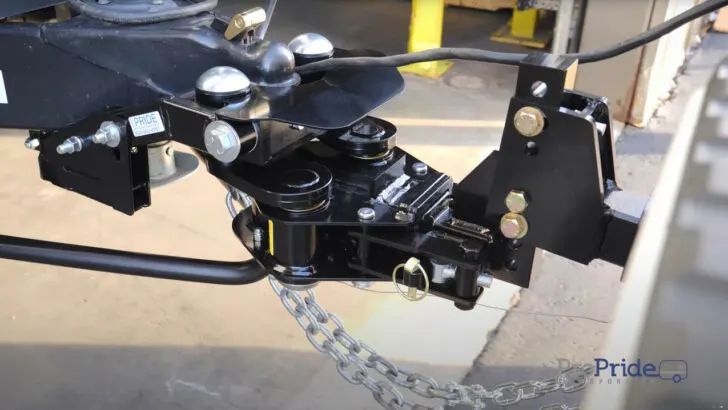
The ProPride 3P is also designed by Jim Hensley, but has several enhancements and improvements over his original design, the Hensley Arrow. (Photo source: ProPride)
The ProPride 3P hitch is available in multiple models, with each designed to handle a different maximum hitch weight:
- 3P-600, for trailers with hitch weight of up to 600lbs
- 3P-800, for trailers with hitch weight of up to 800lbs
- 3P-1000, for trailers with hitch weight of up to 1,000lbs
- 3P-1400, for trailers with hitch weight of up to 1,400lbs
- Sway Elimination, 1000 to 1400 lbs of weight distribution
Note that the Hensley and ProPride hitches are all Hensley-style, and are all designed by Jim Hensley. Likewise, the Hensley Cub and Arrow and the ProPride 3P all use the same basic converging linkage, pivot point projection, and sway-eliminating design. The Propride 3P hitch has some new improvements and enhancements that the original design Hensley Arrow and Cub don’t have.
But the Hensley and ProPride hitches all eliminate sway and provide weight distribution.
What’s the Difference Between the Hensley and ProPride Hitches?
The ProPride 3P® hitch offers an improved design over the original Hensley Arrow (and Cub) hitches and includes enhancements such as an adjustable hitch bar that allows for many different offset positions so that you can get your trailer towing level, which is exceedingly important.
This is a significant improvement over the non-adjustable offset of the original (Arrow) design.
Also, the hitch bar of the ProPride 3P® has a tilt feature that offers improved weight distribution and keeps the hitch head level.
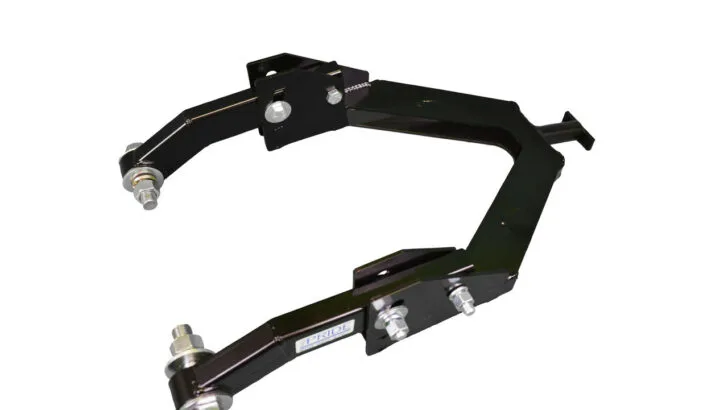
The improved ProPride yoke eliminates trailer movement on the ball, even in the event of a panic stop. (Photo source: ProPride)
Here’s a list of improvements and enhancements made to the original Hensley design that are available in the ProPride 3P® as noted by ProPride:
- Adjustable hitch bar (same equipment adjusts to any towing vehicle)
- Improved hitch bar wedge and hitch box angle to make hitching & unhitching much easier
- One-piece yoke (in place of independent strut bars) to hold the hitch head square to the trailer
- No frame drilling is necessary for the installation, making it easier and eliminating the potential for weakening the trailer frame
- Weight distribution hitch location (on top of the frame instead of hanging from a pin alongside the tongue) offers more leverage, with no possibility of bending the pin, which can occur with the Hensley Arrow®
- Spring bars are bolted into the hitch head instead of hanging on a spring loader, which eliminates the wear that can result in the spring bars falling out of the bottom of the hitch head.
- Pre-treatment with powder coating to prevent rusting and paint chipping
- Thicker control links so they can’t bend (which has reportedly occurred on the Hensley Arrow®)
- Thicker, reinforced hitch box that’s less likely to warp (again, this has reportedly happened with the Hensley Arrow®)
For a more detailed and visual description of the ProPride 3P® and its improvements, we suggest having a look at this YouTube video from Sean Woodruff:
So, Do Hensley & ProPride Hitches Really Eliminate Trailer Sway?
According to users, they absolutely do! But it should be noted that this comes at a cost.
Your average anti-sway hitch might run you a few hundred dollars. By contrast, a Hensley Hitch will cost you close to $3,000 (a little over $2,000 for the Cub), and a ProPride 3P costs a little more than $3,500. The Hensley-style hitches are designed to be far more effective at eliminating sway in all conditions, but you’ll pay a premium.
The trick, as always, is to determine whether or not the difference in cost is worthwhile in your particular situation. You can’t put a price on safety, that’s for sure. But, depending on what you’re towing (for example, a teardrop or a little Casita camper), you may or may not be interested in shelling out 3 grand (or more) for a hitch.
One thing is clear: Users of the Hensley and ProPride hitches confirm that these hitches really do eliminate trailer sway, and most believe the improved towing experience is well worth the cost.
Not only are these hitches effective, but they’re also durable over time. And with a lifetime warranty, the manufacturers are clearly confident that they’re likely to last… well, a lifetime.
They also can be easily transferred from older rigs to newer ones. This is important, especially considering that the hitches may outlive your ownership of a particular rig.
Have You Used a Hensley or ProPride Hitch?
If you’ve used either of the hitches designed by Jim Hensley, we’d love to hear your thoughts. Leave a comment below and tell us about your experience.
Free RVing Tips, Tricks, Reviews, Giveaways & More
Subscribe to our daily newsletter! We’ve been full-time RVers for 20 years (!) and share everything we’ve learned about RVing in our daily blog posts. Join our online community to receive a wealth of great RVing knowledge delivered right to your inbox.
Whether this is your first time on the road or you’re a seasoned full-timer, you’ll love the wide range of RVing topics we cover. Don’t miss a single article or any of our famous RV gear Giveaways — Subscribe today!



James Olvitt
Sunday 20th of August 2023
We used a Reese Cam-Lock for close to a decade. What changed our minds to consider a ProPride hitch seriously was our trip back from Ohio going into Illinois. We had experienced a sway event so bad due to cross winds, we left our 34 ft 6500lb camper at a campground 3 hours from home and went back that weekend to pick it up. That was when we made the decision to check out both Hensley hitches.
Ultimately went with the 3P as it seemed more versatile and their customer service answered every question I had. Seemed like Hensley customer service was irritated at my questions for some reason. Maybe the customer service rep was having a bad day, but that helped our decision process.
We now have since replaced our RV with a 2021 Expedition Max with HD tow and a 2021 Kodiak Ultimate 2921FKDS. Transfer from both units was simple and I didn’t need to get any different parts to make it work. Right now we have towed using the 3P for 18,000 miles and regret not getting it sooner.
TheRVgeeks
Tuesday 29th of August 2023
Glad to hear about that, James. Thanks for sharing your experiences!
Lee Meyer
Wednesday 19th of July 2023
I've got a Hensley Arrow hitch between my 2019 RAM1500 and my 30ft 8500lb travel trailer. Started RVing several years ago with a standard ball based weight distribution hitch. Drove three trailers 30,000+ miles and experienced some trailer sway in medium to heavy winds and beside several big trucks. I was always able to get through these events with judicious adjustments of gas and steering. Knew of Hensley but considered them over-priced.
On first trip with current trailer was on the freeway, on a mild down grade with medium side wind. The trailer started to sway, the sway got bigger and bigger and then bigger. My girl friend was driving. I figured we were toast. Before I could remember to mash the brake actuator on the built-in trailer brake controller, my really expensive truck automatically applied the trailer brakes, then the truck brakes and adjusted the steering to keep everything on a straight line. Highly scary. Really thankful for high tech truck technology. Never want to experience that again. The incident got me to thinking. $3000 is cheap compared to the price of a new truck and trailer.
I've driven 5,000+ miles with my Hensley and it really does stop sway. I do find it more finicky to hitch up than a ball hitch but I'm not complaining.
TheRVgeeks
Wednesday 19th of July 2023
Hi Lee. WOW! Now THAT'S a story! So glad it ended well and that you, your girlfriend, and your vehicles all came out of that situation safely (thank you high-tech truck!!)!
And thanks for sharing your experience with your Hensley now that you have one! So glad to hear that it's doing the job for you!
Jim Slaghuis
Monday 19th of June 2023
Questions...
I'm considering a ProRide P3 hitch. Tow vehicle: 2011 Silverado 3500 dually, 2 1/2" reciever. Towing a newly purchased inTech Navigate, 7,500 gvw, hitch height 26"
Questions about weight distribution, or transfer to trailer axles (using a substancial part of cargo capacity) and weight distribution damage to tongue/frame connection. (any weight distribution, not necessarily Hensley or ProRide) (Tongue/frame damage as seen in some Alaskian YouTube videos, due to construction zones.)
We have come across many construction zones where there is no place for a truck/trailer to pull off to remove weight distribution, or even steep drives at service stations.
Also, as seen on YouTube, KYD recommended for Hensley hook up, to back straight in line with trailer and hitch. Is this necessary to hook up? Can you be 15 or 30 degrees off center and still hook up (as we were in our last camp ground due to trees and fire pits)
We towed the new trailer home on a ball, and have yet to use it. It was not a level tow, we need 4" rise empty, possibly 5" truck/ trailer loaded. The coupler is fixed, bolted to the aluminum frame.
We have towed a 27' bumper pull an estimated 18k miles, empty weight 3,450. Initially with weight distribution, but mostly without. The new trailer is considerably heavier, much heavier tongue weight. I've read 700-877 pounds. No sense weighing it until its level on the truck.
Thanks in advance, Jim Slaghuis Saugatuck, MI
TheRVgeeks
Wednesday 19th of July 2023
Hi Jim... while it's true that many (most?) weight distribution hitches recommend NOT running the weight distribution bars at full force when going on rough/unpaved roads or crossing large driveway abutments, it seems that consensus from owners who HAVE WD hitches is "Gee! Didn't know that was an issue, have never loosened/removed my WD for road construction or driveways... and haven't had a problem!" So we're not sure how rough "rough" is when manufacturers of weight distribution hitches mention it. If you were going on a rutted, washboard, unpaved road back into the back country? Yeah... we'd recommend removing (or at least loosening) the WD bars to be safe (plus, you're not likely driving all that fast over those roads to have to worry too much about sway). But on road construction zones? We'd think you'd be fine.
As for the requirement for being straight inline with the Hensley hitch... we don't think that's as much of an issue with the ProPride 3P hitches. They have a bit more movement built into the head, allowing for more disparity between the towing vehicle and trailer. So you maught want to check that out.
David Bybee
Tuesday 6th of June 2023
I've had my Hensley for about 8 years. Wife remarked she could tell the difference how the rig felt before we got out of town the first time. I wouldn't tow without a Hensley or Pro-Pride.
One day I was towing in a 37 mph side wind. I didn't know it until getting out of the truck and someone tells me how windy it is. Many times I feel the truck moves around less in a wind with the trailer attached.
I also believe it maybe saved my life, my trailer and truck for sure. I had a spring break on my Avion at 55 mph on the passenger side. I knew this because there was a slight jerk of the trailer I never felt before. I looked in mirror and saw a cloud of blue smoke. The leading tire had gone back against the rear tire. I safely slowed down to evaluate the damage. Both struts on the Hensley did their job, but each had a slight bend. They were replaced under the lifetime warranty.
David Bybee
Jack Cooper
Wednesday 31st of May 2023
We have a 30 ft 2020 Jayco Whitehawk 23MRB. We had a Reese weight distribution/sway control installed when we purchased it. We tow with a 2017 Ford Expedition with the HD towing package rated at 9,200 lb capacity. When we got our trailer and took two trips, Ohio to the Smoky Mountains NP and Ohio to Rocky Mountain NP. After the hours of "white-knuckle" driving, I was ready to sell the TT due to sway issues. The Semi-Trucks on I-80 was just too much to handle. The Hensley Hitch was recommended by my RV dealer and after a lot of research, we decided to give it a try (Hensely Arrow). Absolutely the best money we have ever spent on our TT. What I call "truck suck" is absolutely gone. Since the hitch change, we have done three more trips and no more "white-knuckle" driving. Ohio to Shenandoah NP, Ohio to Rocky Mountain NP and Ohio to Sedona, AZ. That's almost 8,000 miles and except for the long driving hours, it has been a pleasurable experience. They give you a 60 day trial once you start traveling to return your hitch for a full refund including shipping. They are willing to do this because they know you will not send it back. Jack & Vicki Cooper Clyde, Oh